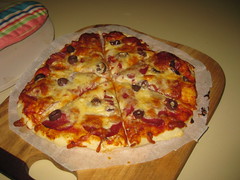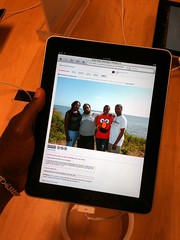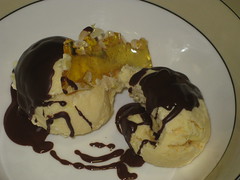
 We probably have pizza of one sort of another every couple of weeks. I’d like to say it’s always home-made. I’d like to say that.
We probably have pizza of one sort of another every couple of weeks. I’d like to say it’s always home-made. I’d like to say that.
However, I can say that we do make our own pizza regularly. So, I’ve been meaning to put up this recipe before, but for some reason it gets eaten before I think to take a picture. But last weekend, I happened to take a couple of snaps, so here’s the recipe.
It’s based on a recipe in Donna Hay magazine (issue 25), but you’ll need to come up with the pizza topping yourself. This time, we had a “leftover pizza” with roast chicken and vegetables, and a salami pizza with salami and sliced olives. I’m always willing to try new pizzas!
Ingredients
1 teaspoon dry yeast (or 1 packet, approx. 7g)
1/4 teaspoon (~1mL) caster sugar
3/4 cup (~190mL) of lukewarm water
1 1/2 cups plain flour
1/2 teaspoon (~2mL) salt
1 1/2 tablespoons (30mL) olive oil
50mL tomato paste
dried oregano to taste (approx 2 teaspoons or ~10mL)
Method
If it’s been cool (like it is in Melbourne at the moment), fill the sink with warm water to a couple of inches, and place a large mixing bowl in it for a few minutes to warm it up. The dough will rise better in a warm bowl.
Meanwhile, put the dry yeast and sugar in a measuring cup and fill it with lukewarm water from the tap. Stir well to ensure all the yeast is broken up. Set it aside for 5 minutes.
Place the flour and salt in the warm mixing bowl, and make a well in the centre. Pour the olive oil and the yeast mixture into the flour, and stir it together with a butter knife to make a dry dough.
Take off any rings or a watch (this stuff sets like concrete). Knead the dough (you can leave it in the bowl) for a few minutes until it is smooth and elastic. This step can be shared with a young child (!).
Cover the mixing bowl with a cloth and leave somewhere warm for 45 minutes, or until the dough has doubled in size. I’ve found good places to be: the shed, the car, or even back in the sink with some more warm water.
You can leave it for longer than 45 minutes, but if you leave it more than a couple of hours, the yeast will have eaten all the sugar and the dough will be rather sour.
When you’re ready to make the dough into bases (this recipe is enough for two medium-sized pizzas), preheat the oven to 220 degrees Celcius. Put the pizza trays that you’re going to use in at the same time, to help ensure a crispy crust.
Pound the dough down into a ball and split into two. Spread each ball out on a piece of baking paper (saves having to flour a bench top), making a flat disc.
If you don’t have a rolling pin handy, or don’t like the hassle of rolling, just pop another piece of baking paper on top of the dough, and using a smooth object (e.g. glass, rolling pin), press the dough out until it is the shape you want.
When you’ve got the two plain bases ready, spread each with half of the tomato paste and sprinkle with the dried oregano. Then, go crazy with whatever topics you like.
Serves 2 adults.


